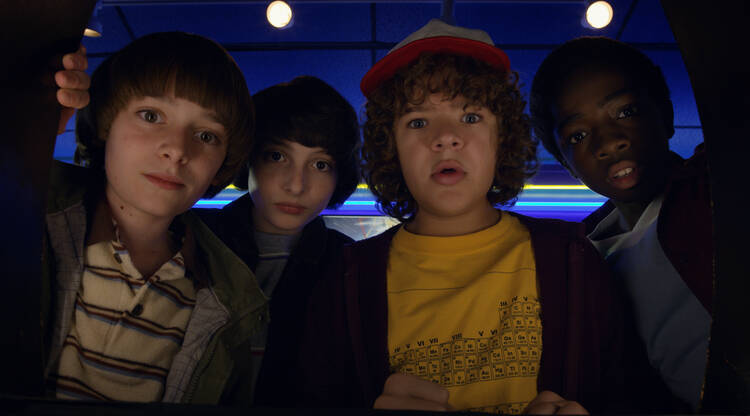“Something is coming. Something hungry for blood.” The words are spoken by Mike Wheeler, the Dungeon Master, with enough passion to will them into reality. It is 1983, in a suburban basement in Indiana. Four friends have been sitting around a card table, playing Dungeons & Dragons for 10 hours. Behind them, hanging on the wood-paneled wall, is a poster for John Carpenter’s film “The Thing.” The kids do not know how much their lives will soon change.
But, because they are kids, they can imagine it. The first season of “Stranger Things” was powered by imagination and wonder and the second is no different. Although two essential characters, Chief Jim Hopper and Joyce Byers, are adults, the series is charged by those four young friends and the mysterious Eleven, a girl who has survived C.I.A. experiments and emerged with radical psychokinetic powers.
The show’s second season arrives on a wave of well-earned hype, and fans will be treated to more of what made the first season so fun. It is 1984. V.H.S. tapes line cabinets next to board games and framed Polaroids. “The Terminator” is in theaters. Radio Shack is going strong. Middle-schoolers flock to the local arcade. They ride their bikes under the moonlight, cutting through wooded trails as they pedal into a world of mystery.
“Stranger Things” uses nostalgia to upend complacency. The show’s familiar pop-culture sights often make it comfortable to watch, especially for those who lived through the 1980s. But we know it is an incredibly uncomfortable world for its characters.
It is 1984. V.H.S. tapes line cabinets next to board games and framed Polaroids.
Will Byers, one of the friends who was abducted and nearly killed in the first season, is still feeling the effects in this sequel. Will was able to survive his traumatic stay in the Upside Down, a sometimes parallel, sometimes intersecting alternate universe. The show is blurry on the specifics, but malleability is good for science fiction.
Will’s sickness and visions suggest that his suffering is not over. His mother Joyce, played again to perfection by Winona Ryder, is still a nervous wreck. In the first season, her audacious faith in the return of her abducted son illuminated her life—quite literally, as she strung a litany of Christmas lights across her home, convinced that Will would use them to communicate with her from the Upside Down. Now there is a bit of optimism in her life. She has a new boyfriend, played by another ’80s throwback, Sean Astin (the asthmatic Mike Walsh in “The Goonies”), but she is still overprotective of Will. He is frail and always seems to be staring into the distance, his body perpetually unsettled.
So much of “Stranger Things” takes place in prosaic settings: basements, bedrooms, hallways, middle schools, stores, libraries. The show’s supernatural elements are kept secret in these mundane locations. Those who have survived the first season are sworn to silence by the same mysterious government agencies whose experiments cultivated Eleven’s power and opened the gate to the hellish other dimension. The characters are trying to get back to their typical lives, but as Joyce warns her new boyfriend, “This is not a normal family.”
“Stranger Things” uses nostalgia to upend complacency.
The first episodes of this new season are a bit slow, but that might be an unfair comparison with the breathless pace of the debut season. When the story starts picking up, it reaches a fever pitch and never stops. An infected and desiccated pumpkin patch leads to everyone’s worst fears: The violent, demonic world they all hoped Eleven had vanquished at the end of last season has returned. Once the show allows its sizeable cast (there are just shy of a dozen notable characters) to go in multiple directions, the staggered storytelling allows for real suspense as the season develops. And some unlikely returns pump new energy once the season reaches the halfway point.
Chief Hopper, played with both strength and endearing depth by David Harbour, remains a steady guide. Hopper is both entirely out of his element in dealing with these otherworldly creatures and somehow exactly the person to help save the town. Still scarred by the death of his own daughter, he seems absolutely determined to forge forward. “Stranger Things” makes us feel this way about all of its characters. Dustin Henderson, often hilarious and always foul-mouthed, learns the hard way not to keep secrets from good friends. Bad decisions aside, he owns each scene in which he appears. In this world, the underdogs can win.
A better word to describe this crowd, though, might be freaks. It is one embraced by the characters. Jonathan Byers, Will’s solemn older brother, whose interest in Mike’s sister Nancy continues this season, says that he and Will should be proud they are freaks, outsiders. Nancy also welcomes her outsider status as a popular girl turned monster hunter; her oblivious parents are stock suburban characters, but for good reason. In the world of “Stranger Things,” the wild and impossible exists along with the commonplace. We all love that period in our lives when we allowed the transcendent to be real. All that is needed to see another world is an open mind and a trip to the basement.








